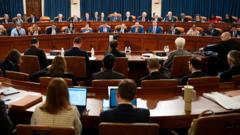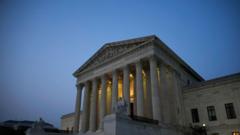The United States has lost its last perfect credit rating as Moody's downgraded it from 'AAA' to 'Aa1' due to rising debt and deficits. This marks a significant shift for the nation, which had maintained a perfect rating since 1917.
US Credit Rating Takes a Hit as Debt Concerns Mount

US Credit Rating Takes a Hit as Debt Concerns Mount
Moody's downgrades the US credit rating, citing growing debt issues and rising interest costs.
The United States has been dealt a blow as Moody's ratings agency has downgraded its credit rating from 'AAA' to 'Aa1', marking the end of its last perfect credit standing. The ratings firm cited rising government debt and interest costs as key factors for its decision. According to Moody's, successive administrations failed to address increasing deficits, leading to concerns over the government’s ability to repay its obligations.
An 'AAA' rating indicates that a country is viewed as reliable and financially healthy, with a strong capability to meet its debt commitments. The downgrade from Moody's, which held the highest rating for the US since 1917, adds to a string of negative assessments from other credit agencies; Fitch Ratings previously downgraded the US in 2023, while S&P Global Ratings did so back in 2011.
In its official statement, Moody's noted that the US government debt and interest payment ratios have climbed to levels significantly higher than those of other similarly rated sovereign nations over the past decade. The response from the White House was pointed, with spokesperson Kush Desai criticizing Moody's credibility and asserting that the administration was working to resolve the fiscal challenges it inherited.
Lower credit ratings typically signal an increased risk of defaults on sovereign debt and usually lead to higher borrowing costs for the country. Despite the downgrade, Moody's acknowledged the "exceptional credit strengths" of the US, highlighting the size and resilience of its economy and the dollar's status as the global reserve currency.
Looking ahead, Moody's anticipates that federal debt could rise to approximately 134% of the country's gross domestic product (GDP) by 2035, illustrating the long-term implications of current debt levels. The momentum of this economic strain intensified on the same day that former President Trump's ambitious spending bill faced hurdles in Congress, with some Republicans opposing it.
According to the Commerce Department, the US economy experienced a contraction of 0.3% in the first quarter of this year, a stark drop from the previous quarter’s growth of 2.4%. This decline was attributed to decreases in government spending coupled with an influx of imports, a reflection of firms preparing for impending tariffs. The developments underscore the complexities facing US fiscal policy and market confidence.




















